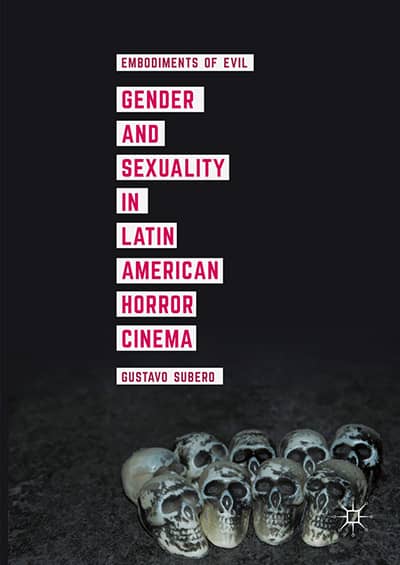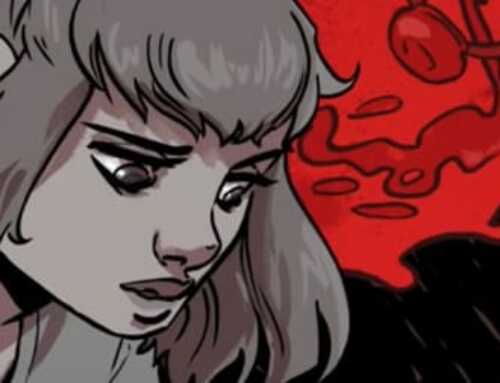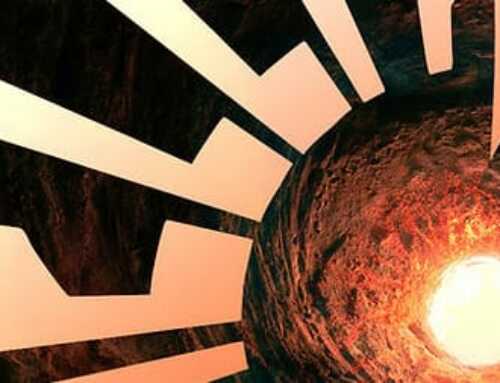Gender and sexuality have had a deep impact on Latin American horror, with their influence becoming more prominent in contemporary Latin American horror.
In his book Embodiment of Evil: Gender and Sexuality in Latin American Horror Cinema, Dr. Gustavo Subero evaluates the role that gender and Queerness have had in Latin American horror from the early Mexican gothic horror of the infamous La Llorona and Brazil’s iconic Coffin Joe, to contemporary films such as Somos lo que hay (We Are What We Are).

Dr. Subero is a Lecturer at Imperial College London. He is also a scholar of visual cultures and intersectional studies. Alongside Embodiment of Evil, Dr. Subero has several other books about the connection of Queerness to culture, including Queer Masculinity in Latin American Cinema: Male Bodies and Narrative Representations.
In our interview, Dr. Subero shares with us what inspired them to research Queer and gender themes in horror, examples of significant Queer and gender themes in influential Latin American horror films, and the roles Queer and gender play in contemporary Latin American horror cinema, such as the Mexican horror film Huesera: The Bone Woman.

Bonilla: How did your interest in film begin?
Subero: I think is gonna sound incredibly corny, but I actually write that in the preface to this book. When I was at university, I did a degree in Journalism and Media Studies. The university had this kind of cinema club, and they were screening Santa Sangre. It was a screening with a tiny TV on VHS. It was a room with like ten or twelve people who really liked art cinema and world cinema.
I remember watching this film and thinking, “What is happening? This makes no sense.” But I’ve never seen anything that interesting. I’ve never seen anything as weird, as camp, and it was turning horror on his head. Alejandro Jodorowsky is just playing with all these ideas around what gender means and what the body means in the context of this pseudo-Mexican environment, in which the film revolves. It was just something that I thought, “It’s just amazing!”
Then, I did an M.A. in film studies. Going then on to a PhD in film/cultural studies.
What inspired you to write about Latin American cinema?
You will see that with my career, I tend to go away from the mainstream. I try to go with things that people don’t necessarily consider serious texts. When I say people, I mean academia. The academic circles at the time, we’re talking the late 1990s, didn’t consider horror to be worthy of [academic] exploration that didn’t necessarily fit into horror cinema.
Beyond Barbara Creed talking about monstrosity and female horror cinema, nobody was really looking at what [horror cinema] tells us about things like contemporary society. When the films do attempt to make a social or political critique, they become metaphors around social interventions, social phenomena, political phenomena, and historical phenomena that have occurred in Latin America. It’s easier to think, “If I do these within the context of horror, I can get away with saying things that I probably wouldn’t be able to if I was doing like a historical [fiction] film.” Cinema has this ability to give permission to be playful but to be also a little bit tongue-in-cheek. You can actually say things without saying them.
Most of my career has been devoted to writing about the Latin American body and Latin America in a very broad understanding. In the introduction to my first monograph, I use Latin America as an almost reductionist term because this idea that we can talk about Latin American cinema is in a way incredibly reductionist. Really, we should be talking about regional cinemas and national cinemas. Especially here in the UK, so we tend to operate in spaces where our Latin American Studies, is very broad, and very contentious.
When did you start analyzing Queerness in Latin American cinema?
When it comes to film, I started looking at the Queer male body in cinema. And that’s where I first started looking at a number of films, pretty much from the 1950s and 1960s onwards in Latin America that dealt with Queer male sexuality, but we are again, [referring to] a very broad understanding of what Queer means. It wasn’t just talking about same-sex desire. If you look at my first book now (Queer Masculinities in Latin American Cinema: Male Bodies and Narrative Representations), that feels quite dated, because I do very little about Trans identity, for instance. But I write a lot about cross-dressing. I write a lot about these attempts to destabilize the gender normative binary system that is so embedded into Latin American culture.
What led you to research gender and Queerness in Latin American horror?
I was trying to dismantle the idea of machismo and dismantle the ideas of the fixity of the body. That’s how I ended up moving into horror cinema. Once I had written that first book, I realized at that point, I was more confident in my career. I was getting older and becoming, it sounds very pompous, but I was becoming a little bit better known within the academic circles. At that point, I said, “Okay, I’m going to write about pornography in Latin America and I’m going to write about horror cinema in Latin America.” I didn’t want to do just a repeat of my first book about Queer male bodies but in a horror context.
Why was it important to cover gender in your book?
The women have always been a fetish, token, a symbolic presence in horror cinema. You couldn’t really talk about horror without talking about women. I really thought that would be a disservice to the genre, to the film, to the directors. This book had to go all the way.
How did you write this book with the limited information available about Latin American horror cinema?
When I wrote this book, the resources were so scattered. The amount of bibliographies out there was so scare. I remember talking to Jonathan Risner, and we were both like, “I’ll cite you and you’ll cite me.” But it was crazy. Where else do we go? There were some people doing one article here, an article there, but it wasn’t anything really concise.
There is a book that deals with horror cinema called Manual de Cine de Género. It’s a book written in Spanish. It’s a very good book that deals with horror cinema. What they did was have people who wrote about anything they wanted, put that all together, and there was a book. It was a clear reflection of the time when there weren’t that many people writing about horror cinema. So I felt that necessity for me to write.
How can it be that we got this incredibly interesting, fully flesh genre of cinema if you look at all the horror cinema that has been created in Mexico, even before 1933, there are some silent horror films from before, I think 1918 or 1920. There is a tradition.
The same thing with Argentina. If you look at the way that Argentina has dealt with anything to do with ‘los desaparecidos’, with Las Madras de Plaza de Mayo. These ways of dealing with the trauma of the post-dictatorship. I realized that there were countries that had a history of horror cinema. There were countries that had attempted to create a body of horror.
What did you find interesting about the female villains of Mexican horror?
I realized by watching many early Mexican horror cinema, that the female villainous were so interesting. There was so much to say about these women who were breaking with patriarchy, who attempted to destabilize gender norms. I felt it would be a disservice not to talk about this.
In Huesera, how does it evaluate the virgin and the whore cinematic tropes?
Huesera deals so well with this tension that has always existed between the figure of La Malinche as the whore, the prostitute, the one who betrayed the Mexican population. And then we have the Mariana figure, the virtuous, the domestic. Huesera is [in my view] an anti-Mariana film.
It’s anti-Mariana in a way that we need to start to understand La Malinche as a figure of devotion. As a figure that needs to be revered. Not to be ostracized. Not to be hated. It’s talking about a new type of femininity.
With Mexican cinema, I’ve always loved it when the horror genre allows [audiences] to really criticize what it means to be a Mariana or what it means to be a La Malinche. And, how difficult it is to live to either expectation. It’s a no-win situation for women. You’ll always come out losing.
What does the Lesbian relationship in Huesera represent?
When I saw Huesera, I thought that it was at its most so erotic, when it was about the women. When the protagonist (Valeria) is with the woman (Octavia), with whom she kind of had a relationship in the flashback sequence, I thought Huesera was saying, “I don’t care about the patriarchy. I don’t care about heteronormativity because this is a film by women for women.” The moments of real tenderness, the real eroticism is when she’s talking about just women without paying any attention to men.
In your evaluation of We Are What We Are, you mention that the film challenged patriarchy and how machismo was being emasculated. How does the film accomplish that?
The film is very vague in that. That’s one of the things that I felt critics disregarding completely, the Queer aspects of the film. Maybe I chose to see this as a lover of Queer films, because of my academic background. I can’t deny that. I will be very biased by the work that I’ve done historically up to this point.
One of the things that I found with We Are What We Are, is that by the end, the protagonist realizes that the machismo that he’s trying to live by, that he feels is the prototype of male behavior that will be accepted. He’s already leaving with the tensions of being a cannibal. That’s in itself incredibly transgressive. Unlike other films, where the transgression is problematized within the household. The family are cannibals, but they have issues with being cannibals, but they can’t stop being cannibals.
For me, when Alfredo kisses the other boy, I think that’s the moment in which he says, “Okay, I cannot have all of these dictates of gender behavior and gender norms, telling me what to do, as well as the societal behaviors, the societal norms, and the legal norms. So, some things got to give. I’m going to at least embrace my Queerness. I’m not going to let machismo emasculate me.” Or at least that’s how I read it. He kisses this boy only to then kill him.
That is a moment of realization I think shows well in the film. I quite like the idea because it’s one of those films that says, “I’d rather live my own self, but I will continue to disrupt the parameters of a functioning society by having to kill people because I need to eat them.”
I think that is how machismo is emasculated. The brother (Julián) is a prototype of the macho we hear in boleros. But you have to get rid of the machismo in the film, for Alfredo to really embrace that queerness.
I remember that moment when Alfredo was like, “No, I can’t continue hiding so many things. So of all the things I choose not to hide anymore, I’m going to go for this one.” I think that is quite interesting.
There is a whole body of Mexican cinema that shows a real understanding of Queerness. If you look at the work of Julián Hernández, these ideas of machismo are becoming incredibly redundant and really obsolete. That’s why for me, We Are What We Are was one of those moments when I went, “Oh my God!” It’s such a well-created film, but then the ending I was like, “Oh Wow!” I love that.
What is one of your favorite examples of Argentinian Queer horror?
Memory of the Dead is one of those films that when I saw it, I thought, “Oh, my God!” Because it’s a gift that kicks the butt of patriarchy and to these gender norms that have been so typical of many Latin American cinemas. Our society itself is not necessarily or historically has been the most progressive.
In Memory of the Dead, after Jorge dies, all of the close friends of Jorge plus his widow, get together to pay homage to him. But some of them don’t know that the wife and ‘a friend’ (Nicanor) have decided to do a ritual in which by killing the rest of them, they can bring Jorge back to life.
By the end of the film, there is only the wife, a friend, and Nicanor, the guy with whom the wife was working together with. They need to kill one more person. Then, Nicanor out of the blue kills both the other friend and the widow. The ending sees Jorge leaving the house, now a resurrected body, who says, “I was waiting for you to finish this. And now we can be happy together.”
Oh, it was a ruse all along! You guys [the Queer couple] were doing this [planning of all the killings] and killing everybody. Now, you can be Gay and happy together. This is so cool! I feel you can get away with saying the things about a Gay couple living happily ever after in horror, which perhaps, in a film 10 years ago would have been seen as risky. That’s a little bit too much. Now it’s become a more commonplace, which is great.
What makes the Brazilian horror icon Coffin Joe a Queer Latin American horror character?
I was trying to reach this idea that if we think about Dracula and Coffin Joe, these characters are so Queer in the presentation of self, in their mannerism. With many of these characters, there are links between Europeanization, class, and culture, that makes them other. So that idea that you are not proper Latin American, because you are too Europeanized, you are too refined, or you’re too well educated. With Dracula coming from Transylvania, that’s the perfect reason.
Coffin Joe is so camp, so over the top. What I love is that he becomes the epitome of masculinity by doing everything that we’ve been [in patriarchal societies] told all our life that masculinity isn’t.
The affectation in his speech. When you listen to the Brazilian Portuguese, he’s using a very ornate type of Portuguese. He’s not using the Portuguese that is spoken in the street. That comes with that idea of refinement. The othering of the character. It’s so contradictory. When I wrote about Coffin Joe, I got in touch with all my friends in Brazil, asking, “Am I going in the wrong direction here?” Historically, he’s seen as a macho. That is how they construct him.
Coffin Joe is beyond just being a character in a horror film. He has entered the cultural imaginary of Brazil in ways that it becomes a cultural reference. Even young people still talk about him. They know who he is. They might not even have seen the movies, but they know who Coffin Joe is.
I so enjoyed seeing a character that was blatantly going against these ideas of what the norm [patriarchal/macho-oriented] is. The idea of how the behavior of a macho man and how it is understood culturally. Also, he’s depicted as sexually depraved and sexually insatiable. So, he is trying to conquer all the women that he can find.
What I love about those films is that these women always have a local man that was the love interest before Coffin Joe showed up. These men are the epitome of the type of masculinity that we’ve gone to revered and accept as culturally acceptable. Then, this man coming with his top hat, his cape. He’s so flamboyant.
His interactions with other male characters are very much at the level of getting rid of them in order to conquer women. But not necessarily about a potential love interest or sex interest.
That’s why I think that there is this Queerness. But at the same time, he tries to really hold on to these kinds of machismo where he’s only after women, naked women, especially when you look at This Night I’ll Possess Your Corpse. That becomes a little psychedelic. The one thing we don’t see is him transgressing the object of desire. And I think that that’s quite interesting.
Which Latin American horror films would you recommend to someone who’s interested in seeing Queer or female representation?
My favorite in terms of being horror, it will have to be La Llorona by Jayro Bustamante. But I will have to say that as Queer horror, I’ll probably go with We Are What We Are. It’s so well made. I think Grau does a great job with the cinematography, the editing, the music.
What is your hope for the future of the Queer presence in Latin American horror?
I feel that there’s gonna be so much that is going to emerge. As the conversation evolves around notions of sexuality, of gender, of how we understand our own identities as people who are more complex than just being straight or Gay, part of a binary, where it’s all so black and white, new narratives around all the ghosts, or apparitions in Latin America will start appearing. This will really start looking at the way in which we see ourselves depicted in these metaphors, which is basically how horror cinema operates.
Are you currently working on or planning to write another Latin American horror cinema book?
We are putting together a book on women filmmakers making horror cinema in Latin America. It’s not just men who are going out there making really good horror cinema. These women have loads of stories. Loads of things that they want to talk about. We see these women come out with these amazing films. I think that’s great.







